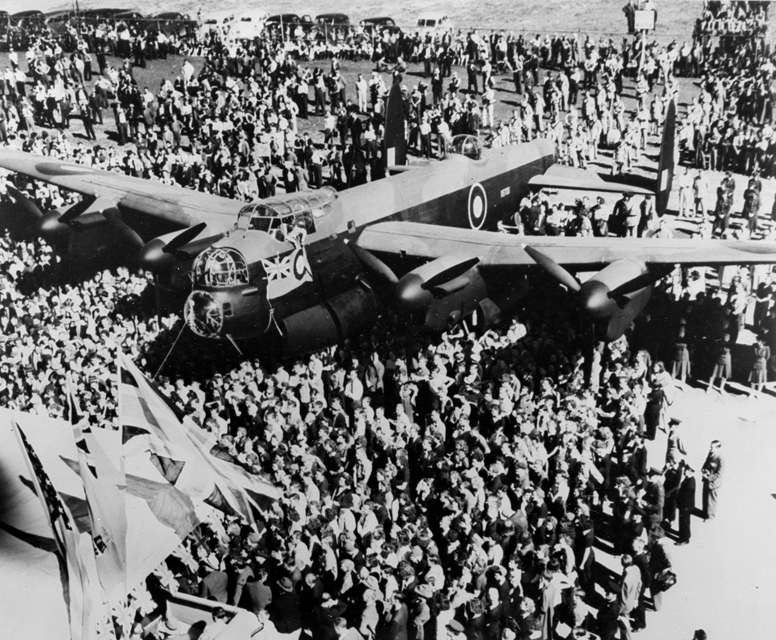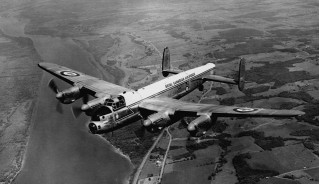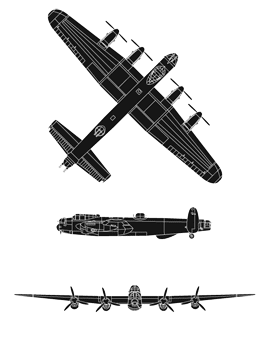Avro 683 Lancaster X
Highlights
- Used in many successful (primarily nighttime) bombing raids, including the May 1943 Operation Chastise by No. 617 Squadron RAF (“the Dambusters”), the “Lanc” was probably the most widely known heavy bomber of the Second World War
- Continued to serve with the RCAF after the war–in maritime patrol, photo survey, search-and-rescue, and navigator training–until 1965
- Had a wartime crew of seven: a pilot, a flight engineer, a navigator, a bomb aimer, a radio operator and two gunners
- Usually had a postwar crew of eight: two pilots, a flight engineer, two navigators, and three radio officers
- Flown by many Canadians during the Second World War, including pilot officer Andrew Charles Mynarski, who won a posthumous Victoria Cross for bravery during an attack on Cambrai, France
- First flight was in June 1941 (Lancaster I)

Artifact No.: 1967.0640
Manufacturer: Victory Aircraft Ltd.
Manufacturer Location: Canada
Manufacture Date: 1945
Acquisition Date: 1964
Registration Number: KB 944 (RAF)
History
The “Lanc” was arguably the best heavy bomber used in Europe in the Second World War. Although somewhat vulnerable to fighter attack, it was relatively fast, had a high ceiling, and could carry enormous loads for its size. Victory Aircraft at Malton, Ontario, produced the first Canadian-built Lancaster, a Mark X, first flown on August 1, 1943. Many Canadian-built Mark X’s served overseas with No.6 Group. The Lancaster continued in the RCAF until 1965 for maritime patrol, photo survey, search and rescue, and navigator training.
Wartime crew was a pilot, flight engineer, navigator, bomb aimer, radio operator, and two gunners. Peacetime maritime patrol crew was two pilots, a flight engineer, two navigators, and three radio officers. A late Mark X, the museum aircraft has a Martin upper turret with two 50-calibre guns. Maritime patrol versions had no top turret, and only the front turret was armed with two .303-calibre machine guns. Drafty, noisy, and uncomfortable on long flights, the Lancaster was nevertheless strong, reliable, and a delight to fly. Pilot Officer A.C. Mynarski won a posthumous Victoria Cross for bravery in a Canadian Lancaster during an attack on Cambrai, France.
Current location
Second World War exhibition, Canada Aviation and Space Museum
Provenance
Transfer from RCAF
Built in 1945, this is the most complete Lancaster X in existence, remaining very close to its wartime condition. It was delivered overseas to No. 425 Alouette Squadron RCAF in May 1945 but arrived too late to take part in bombing operations and was placed in long-term storage the same year.
In 1952, it served with No. 404 Maritime Patrol Squadron RCAF in Greenwood, Nova Scotia for a short period of time. The RCAF restored the aircraft in 1964, applying the nose art and squadron markings of an aircraft from No. 428 Squadron, RCAF. The tiny bombs painted on the port side of the nose indicate the number of sorties the aircraft made. The Lancaster was placed in the RCAF’s historic aircraft collection in 1964 and was transferred to the museum, along with the rest of the collection, later that year.
Technical information
- Wing span
- 31.09 m (102 ft)
- Length
- 21.1 m (69 ft 6 in)
- Height
- 6.2 m (20 ft 4 in)
- Weight, empty
- 15,985 kg (35,240 lb)
- Weight, gross
- 29 484 kg (65 000 lb)
- Cruising speed
- 322 km/h (200 mph)
- Max speed
- 438 km/h (272 mph)
- Rate of climb
- 277 m (910 ft) /min
- Service ceiling
- 7,530 m (24,700 ft)
- Range
- 2,671 km (1,660 mi)
- Crew
- seven (wartime)
- Power plant
- four Rolls-Royce (Packard) Merlin 224, 1,620-hp, 12 cylinder V engines



